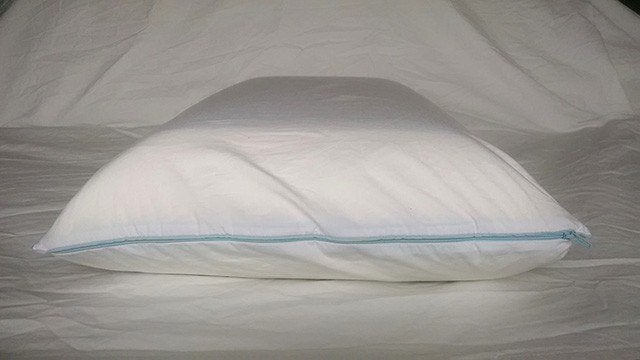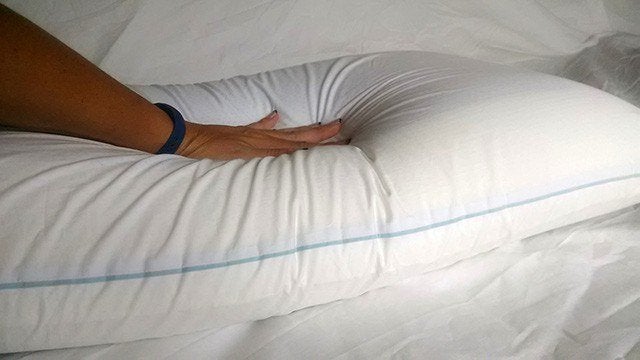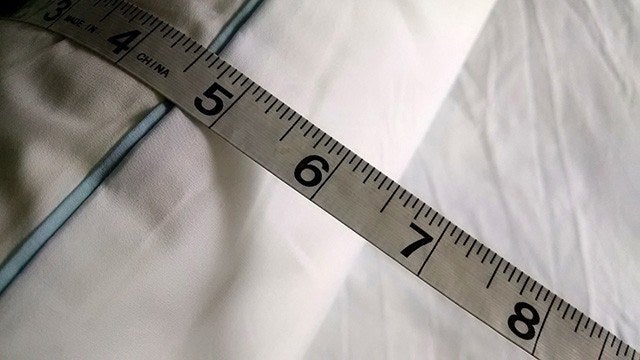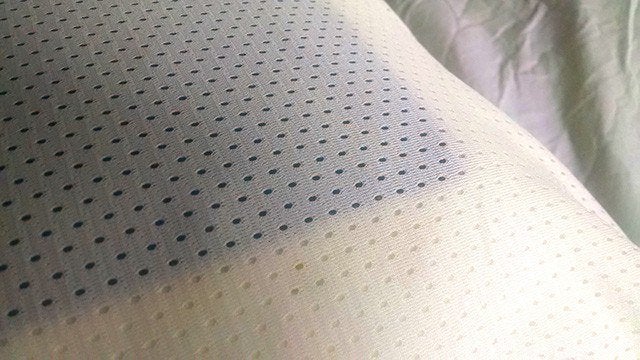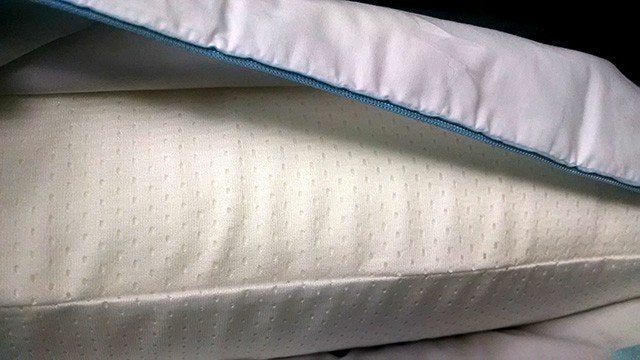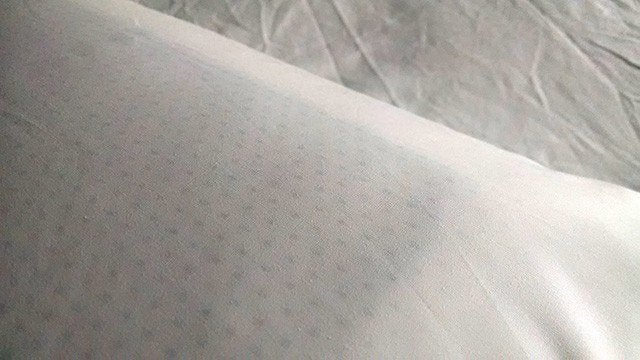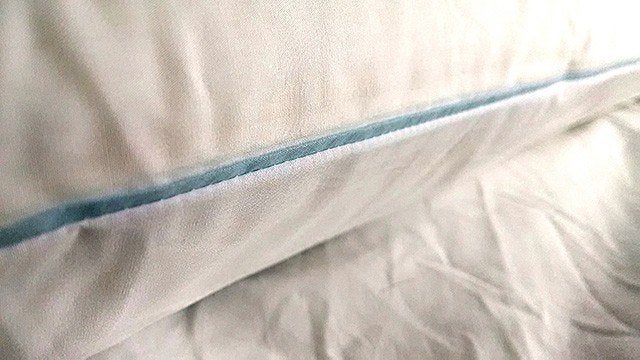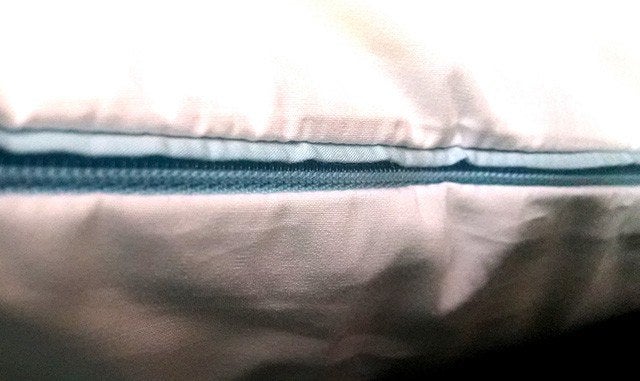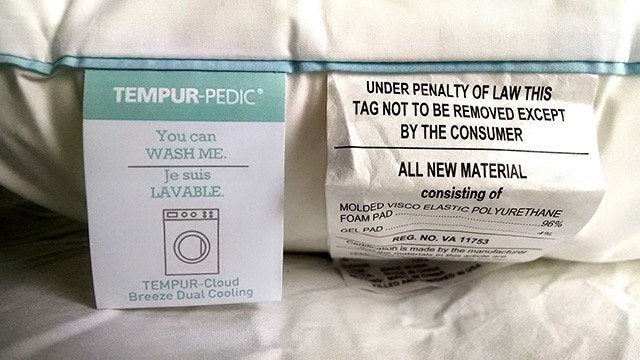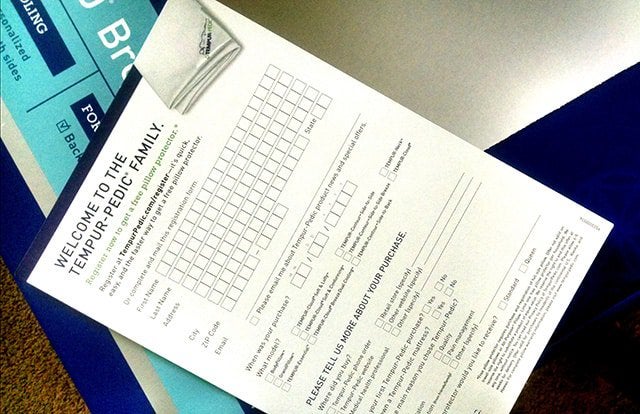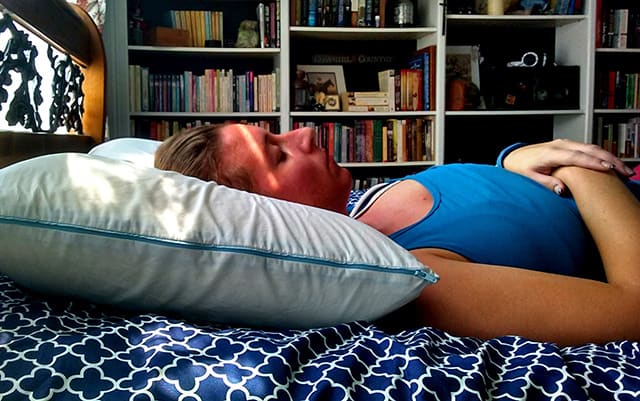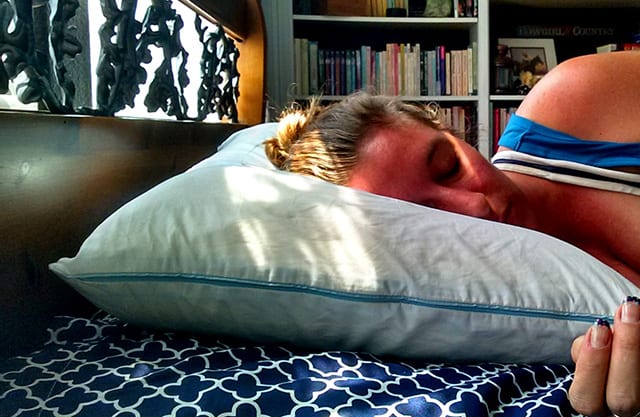Did you know that a cooler night’s sleep not only aides a more restful sleep, but also has a long list of health benefits? Even if you consider yourself a ‘hot’ sleeper, there are a few things you can do to help control your sleep environment that other than turning down the thermostat and turning on the fan.
Cooler sleep surfaces are one way to help influence this type of restful encounter, and many products claim cooling materials and constructions to help this happen. There are many variables to take into account surrounding, if, how, and why this may occur that I’ll explain below, but since your head is a constant source of heat regulation for your body, the type of pillow you choose can be very influential to this effect.
Here at The Sleep Judge we have purchased this pillow to determine if the claims it makes surrounding cooling are up to par. Our honest opinions and findings are found below, so keep scrolling!
Breakdown of the Tempur-Cloud Breeze Dual Cooling Pillow
The TempurPedic Company has been around for a quarter decade and was created by former NASA space engineers who developed their patented memory foam to address flight comforts. They took this material and applied it to an everyday product that often can have a profound effect on a person’s overall health: the mattress.
The last 25 years has seen a surge of innovative designs and application to help meet the needs within the sleep industry. Since memory foam traditionally has a higher heat retention rating, the company has continually sought new ways to help adjust the comforts of their products to create a cooler night’s sleep.
Their cooling pillow designs include a gel layer to help increase air flow and keep heat from being retained next to your body. Focused for back and side sleepers, it claims are that you won’t get a more comfortable, cooler night’s sleep anywhere else.
- Gel layer draws heat from your body
- Breathable, removable casing
- Memory foam contours to support head and neck
- May be too soft for some side sleepers
- Very heavy
- Cooling may dissipate over time
Unpacking
This pillow comes amazingly well protected in its own informative box, and wrapped in plastic. I was shocked at how heavy the box was, and was appreciative of the care taken in the shipping as it was obvious that the foam could have very well been compressed if not within the box and shipped just wrapped in plastic ina looser container like so many other pillows are.
Upon opening there was a slight chemical, off-gassing smell that almost immediately dissipated. I could still smell it when I pressed my nose against the pillow, but within a few hours it wasn’t even noticeable.
Cooling Benefits
The Tempur-Cloud Breeze Dual Cooling Pillow combines their patented memory foam design with a dual cooling gel layer to create the ultimate cooling pillow. What isn’t explained, however, is that no material or fabric can actually ‘create’ a cooling effect. Rather, the cooling effect that is felt is actually a combination of fabric and materials and how well they allow air to freely flow through them.
The choice of fabrics and materials that are used in pillow construction can make or break the claims made surrounding cooling effects. Natural fibers, such as cotton and bamboo breath naturally and allow for maximum airflow. The tightness of fabric weaves are also very important, since the tighter the weave, the less able air is able to pass through- making it less breathable.
Products that claim a cooling surface generally always use low thread-count (a loser fabric weave) and cotton casings over their pillows.
Certain materials are also used to help draw heat away from your body. Many times gels, or other synthetics, can do this if properly constructed- and allow for increased airflow through open pocket designs or allow heat to dissipate away without being retained.
Sleeping hot at night is caused by many factors, many of which are often within your control. What you choose to wear, and cover your mattress and pillow with, are part of those variables you can change to increase your chances of a cooler sleep. Sleeping in breathable clothing, and covering your bedding in a fabric that has a thread count below 300 increases air flow and allows heat to move into the surrounding atmosphere rather than being trapped next to your body.
TempurPedic has always made some pretty hefty claims about their products, and their cooling line of products are no exception. The Tempur-Cloud Breeze is a soft memory foam series introduced by the company in 2012 to address consumer complaints of the typical memory foam heat sink that sometimes occurs with deep contouring surfaces. They recently expanded the line to include pillows to provide a soft, cooling experience.
This memory foam is the softest they offer, and despite the deep contouring it provides, the extra gel layer allows for a entirely unique surface comfort that is supposed to draw heat away from your body and allow it to dissipate into the surrounding atmosphere. They claim this type of construction will provide the comfort many claim, without the problems that surround trapped body heat. I, myself, am not a hot sleeper, but I recruited a few friends to give this pillow a trial spin. I also tried it out in multiple controlled environments, one being of an average sleep temperature, the other in a significantly warmed room.
Features & Benefits
Like most products that lay claim to some serious comfort granted to change some aspect of your life, this pillow has a pretty extensive range of features and benefits to consider prior to purchase. The Sleep Judge team has checked out each in detail and provided our results below.
Sizes
This pillow is available in two different sizes, a queen size version, and a king size version. The queen measures 19×27, and the king 19×35, which is slightly smaller than the standard 20×26 and 20×36 that most pillows measure.
The queen size is an excellent choice for most sleepers and provides support for most back and side sleepers. The king-sized version is a possible choice for larger, wider bodies who need the extra support for their shoulders. The slightly higher loft is also a better choice for a heavier body.
Although the company also states this is a great choice for stomach sleepers, as a stomach sleeper myself I found it to have too high a loft for any sort of comfortable position. But I did thoroughly test out a queen size version and found it to be a perfect size for both side and back sleeping positions.
Memory Foam Filling
Memory foam quality is measured in pounds per cubic foot, and the heavier the weight, the better the quality. Even though the foam Cloud Series is the lightest and softest of the foams offered by the company, weighing in at 4.1 lbs/cu.ft, it is a seriously heavy pillow – weighing in just under 9 lbs on my scale.
TempurPedic foam is a patented design, and is supposed to be amongst the best in the business. I can attest to the amazing contouring and overall support it did provide my head and neck. Even though it did not compress enough to make stomach sleeping comfortable, and compression my weight did cause was quickly reshaped after after removing weight.
This is considered a soft pillow, although I found it to be more of a plush feel, meaning it provided soft comfort with an underlying firm support.
High Loft
Overall this pillow has a pretty high loft, measuring in right about 6.5 inches in height. It also keeps this height during added weight in true memory foam fashion, and doesn’t redistribute filling throughout the pillow.t. Rather it shapes to your head, keeping both surrounding loft as well as a soft supportive surface beneath.
Dual Gel Pad
The cooling gel pads found on both sides of the pillow are the key material addition added to the pillow construction to keep you sleeping cool and comfortable. These pads cover almost the entire surface of both sides, barring a frame of about 2 inches all the way around.
Typically, the science behind gel pertains to conduction, namely the process in which your body heat is transferred to the gel through your contact with it. This heat is then spread along the gel layers, or even dissipated into the foam found beneath it. Poorly constructed gel layers are not often thick enough, and after an initial cooling feel they often become too ‘full’ and your cooling sensation goes away.
My results surrounding the gel started upon my initial contact with it. Upon unpacking, a cooling sensation was immediately felt when I placed my hand upon it. Although this ‘cooling’ isn’t as strong the longer you consecutively use it, it did continue to feel of a comfortable temperature through all trials.
Breathable, Removable Cover
Cooling materials can only work if they are allowed. Gel that helps draw in heat needs to be in contact with your body in order to help draw heat from it, so a breathable cover is important to reap the benefits. Tempurpedic provides a breathable, removable 100% cotton cover that you can use in conjunction with your own low-thread count pillowcase for added protection, or on its own. Either way excellent air flow should be allowed both to and from the gel pad and memory foam construction.
In fact, the gel pad is easily viewable through the cover, ensuring you do not have any thick layers of fabric interrupting how well it works.
The seems are double stitched as well, so the cover can hold up to weight distribution and memory foam shaping without placing unnecessary strain upon the seems.
The zipper is also well constructed and is a lay flat design that keeps it from snagging or rubbing against your pillow case. It also helps the pillow casing keep its shape without any unsightly curves or bends zippers that are not sewn correctly can often do.
Pillow Cleaning- Cover ONLY
This cover is also machine washable and serves as a decent barrier between the pillow and your head. If anything is spilled or stains the pillow itself, first blot your pillow dry and then spot clean only. DO NOT WASH as water can break down memory foam and also it rarely dries completely due to the density of the foam cellular structure- creating breeding grounds for bacteria and mold.
If you need to refresh the pillow itself, simply roll up tight and compress it a few times in each direction. This allows it release any possible dust or other particles that may have settled in it. Plus it helps plump it back up.
5 Year Limited Warranty
Due to the personal nature of a pillow there is no sleep trial, but the company does offer a pretty generous 5 year warranty that covers workmanship and material defects. Tempur-Pedic takes a lot of pride in what they produce and often offers support through the life of their products. Their pillow are no exception, and if seams are coming apart, the pillow compresses more than what is deemed acceptable, or other obvious defects make themselves known- they will either repair or replace the product at no cost to you. When you register your product you also get to take advantage of a great offer that provides you with a free, breathable pillow protector.
Know that you most likely will need to buy this product direct from TempurPedic, or an authorized dealer, in order to take advantage of this warranty. Beware in some cases you probably will have to pick up shipping both ways as well.
Consumer Reviews
Consumer reviews are overall very positive surrounding both side and back sleep experiences. Some side sleepers found it to be a bit too soft for their overall liking to use as a stand alone choice, but mentioned that it conformed nicely to their neck for proper support, especially if they placed another pillow under it. Many also mentioned the ‘cooling’ effect caused by the gel was immediately noticeable against their skin, and looked forward to use during the warmer months.
Complaints focused on it being too soft for certain sleepers, overall compression issues that may occur over time (part of the natural settling process memory foams have), as well as the cooling effect not lasting through the night. A few mentioned that heat sinks created too much warmth, which could be attributed to a poor fabric choice for their pillowcase.
My Cooling Sleep Trial Experiences
The cool feel of the gel layers truly is noticeable upon laying your hand on the pillow. Knowing that gel absorbs body heat through conduction, I was curious to see how well this effect would last through the night in a warmer room; in theory a warmer room would also begin to warm the gel through this same conductive process. I rarely get warm through the night, and ran a series of tests using differing room temperature variables, as well as differing thread-count and fabric choices to see how much of this I may notice when a less breathable cover was used.
My Trial Room Temperatures Variables
I generally keep my room right around 72 degrees through the use of air conditioning and ceiling fans. I made sure to sleep a few nights at this temperature, and also to allow my room to heat up through the afternoon by turning off the AC. These trial nights fluctuated in the lower 80-degree range- which wasn’t horribly uncomfortable when at rest, but did create a much more humid environment than I am usually used to within the house.
My Trial Thread Count Variables
I’ve mentioned a few times how the airflow through material choices and fabric weaves can be affected by how high a thread count is. Material breathability is a crucial part of keeping you cool, and gel layers depend on air flow to help draw heat away, and also allow dissipation. Although the pillow does come with a 100% cotton casing, it is fairly thin, and honestly is not a true pillowcase, so I used a 250 thread-count cotton casing to allow for maximum air flow within both temperature trials.
I also used a cotton/poly blend microfiber pillow case that has a 750 thread-count weave within both temperature trials to determine if the cooling was, in fact, interrupted with the use of a heavier material.
Results
I had some surprisingly different results through the many nights I spent with this pillow concerning cooling, although it was a very comfortable side sleeping choice for my average sized body. I’m 5’4 and felt that my head was firmly supported by the pillow in a very soft memory foam sink. More importantly my neck was provided excellent contouring and cervical alignment.
As for further comfort, it also was a great back sleeping choice, but as a preferred stomach sleeper, there is no way that this pillow can provide a supportive alignment in this position. To start, my face was pretty much enveloped by the pillow due to the contouring, but what’s worse is how high my head was lifted above my shoulders. Perhaps a larger, heavier sleeper may be able to pull this off, but not for the average person- in my opinion.
Tempurpedic Cloud Breeze Pillow Back Sleeping
Tempurpedic Cloud Breeze Pillow Side Sleeping
This was an amazing comfortable sleep that I plan on repeating often. The pillow was refreshingly cool to sleep upon and the plush support was just right. I had no issues with warmth, and upon waking was happy to say that the pillow was still cool to the touch.
Result: Cooling gel layers did what it claimed and pulled heat away from the body for a cool, comfortable night’s sleep.
Although I did sleep well during these nights, I did have varying results upon waking. Each night was a comfortable sleep, but the cooling effect that I made note of with the cotton casing was entirely gone with the heavier fabric. The pillow felt cool upon initially laying on it, but within a few minutes that affect was completely gone- making me think the coolness was a product of the pillowcase rather than the pillow. Most nights I slept perfectly fine and never noticed any uncomfortable temperatures.
However, I did wake feeling slightly warm a few mornings during this trial period. Although the pillow itself felt about at room temperature – I didn’t really associate my body temperature with the pillow or pillow case. It is possible that my body heat wasn’t dissipating away from the pillow or casing fabric as well even though the pillow itself wasn’t warm.
Result: A high thread count casing definitely interrupts how effective the gel layers work to help draw heat from your skin. Combined with the contouring memory foam, heat sinks probably were occurring depending on my sleep position since the fabric weave didn’t allow a high amount of air flow.
When I fell asleep the pillow was cool to touch, but upon waking it felt more of a room temperature, and the cooling effect wasn’t at all noticeable. This makes me think that through the night the pillow equilibrated with the room temperature and wasn’t drawing heat from my body as easily as it did in a cooler atmosphere. The pillow was still comfortable to the touch however, and never felt as if it was retaining heat in any way.
Result: The room temperature seems to affect how effective the gel layers are, and although they still seem to work perfectly fine, the cooling sensation may not be as strong as you like through the night. I would anticipate that anyone who sleeps hot to begin with would not have found this a comfortable sleep temperature wise.
This is not a good combination. The microfiber casing combined with a warmer room temperature made the pillow surface actually feel warm after about 10 minutes. I definitely noticed a heat sink when sleeping on my side with this situation. Memory foam in general is not always the best choice is warmer climates unless it is allowed to breathe correctly, and this trial proved this point very well. I had to trade out my pillow with something else to even get to sleep.
Result: Memory foam contouring, no matter what kind of gel layers it includes, creates a heat sink if air flow is restricted. If you use this pillow in any sort of warmer atmosphere be sure to use a breathable pillowcase.
My Opinion
This is a great pillow, but don’t expect the gel to provide a cooling effect all the time. It works by drawing heat away from your body, and if the temperature of the room and your body overwhelms it, the pillow may not feel as cool at you would like. With that being said, I never found the surface to be uncomfortable temperature wise unless I specifically used a high thread count weave that inhibits air flow in an already warm atmosphere.
I really feel that this is a great for hot sleepers who are already controlling their sleep temperatures. People who sleep hot often keep a cooler room to begin with, and this pillow will only provide further relief in these situations.
Alternative Opinions
To help verify my results I had two other people try this pillow out using both a high and low thread count pillowcase. One, a large male who generally sleeps hot no matter the circumstances and is a side sleeper, loved this pillow in his regularly cooled room. It was a bit too soft to work as a side sleeping pillow on its own, and he propped it up with a thinner pillow beneath in order to provide better head and neck support. He found no fault with this and was very happy with his cotton pillow case trial and commented on how cool his head felt through the night.
His comments surrounding the microfiber case included his observation that the pillow no longer felt cool, although it did not create a heat sink either. Overall he slept comfortably with the pillow in his regular room temperature with either pillowcase.
My second sleeper was another average sized woman who, like me, rarely gets warm during the night. Her trials mimicked my own with almost identical results. In fact, she refuses to sleep with any other pillow and ordered her own.
Result: The cooling gel is incredibly effective with a variety of sleepers, and although works best in a room that doesn’t interrupt its conductive properties against your skin, does help provide a noticeably cooling effect when used with a cotton casing. Otherwise it’s just a very comfortable sleep surface for most sleepers.
Trial Conclusion
Anything other than a low thread-count, cotton casing may interrupt the cooling process these gel layers provide. This includes any type of pillow encasement or protectors you may be in the habit of using.
Multiple trial users were very happy with both the comfort and cooling effects this pillow lends to your night. A warm environment (or the wrong pillowcase) may be a bit too much overall for the effects of the pillow to truly ‘kick in’, causing the memory foam to create a heatsink and could lead to an uncomfortable experience.
Overall Rating: 4.8
The Tempur-Cloud Breeze Dual Cooling Pillow is a fantastic choice to help keep you feeling cooler. However, due to the conductive nature of the gel, your cooling comfort can be affected by the ambient room temperature, as well as anything that inhibits free airflow through the pillow. In order to reap the benefits of this particular product, use a cotton pillow case with a low thread count.
It does provide excellent comfort, and is constructed from a high-quality memory foam, but it is a softer comfort which may not always work for every sleep preference, or every sleep position. Side sleeper may find they need to use a pillow underneath it to get truly comfortable, but it seems a small thing compared to the overall cooling comfort it creates. The reviews that mention that it becomes flat over time are a bit concerning as this can often be a complaint surrounding the use of foam in sleep products. However, the 5 year warranty is a perk to take advantage of if needed.
Conclusion
If you sleep hot, or are looking to help aide in a cooler night’s sleep, the Tempur-Cloud Breeze Dual Cooling Pillow is a must for memory foam lovers. The soft contouring provides the perfect blend of a plush comfort and firm, yielding support for most sleepers. When combined with the dual gel layers that help pull heat from your body and trap it away from your skin’s surface, you end up with a cooler night’s sleep.
Since sleeping cool is conducive to your overall health and well being, as well as a deep, more fulfilling rest, giving this product a try should definitely be considered.
Frequently Asked Questions
What sleep position is this best suited for?
Back.
What is the loft?
6.5 inches.
Will I experience a lot of offgassing?
Average for memory foam.
Is it organic?
No.
What’s the warranty?
5 years.
